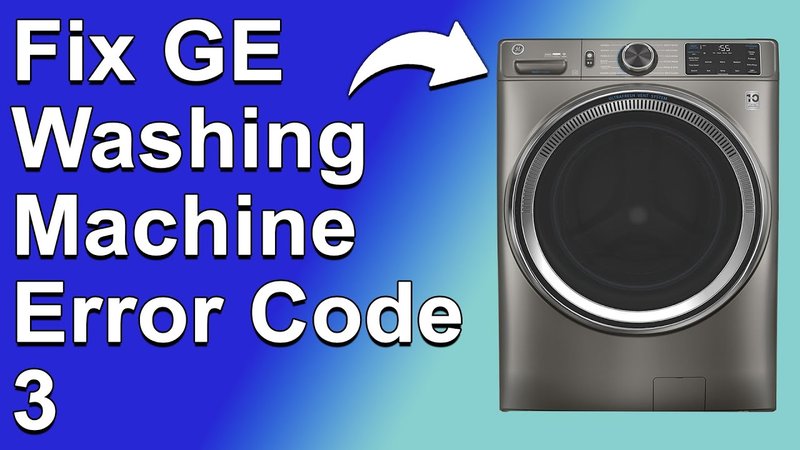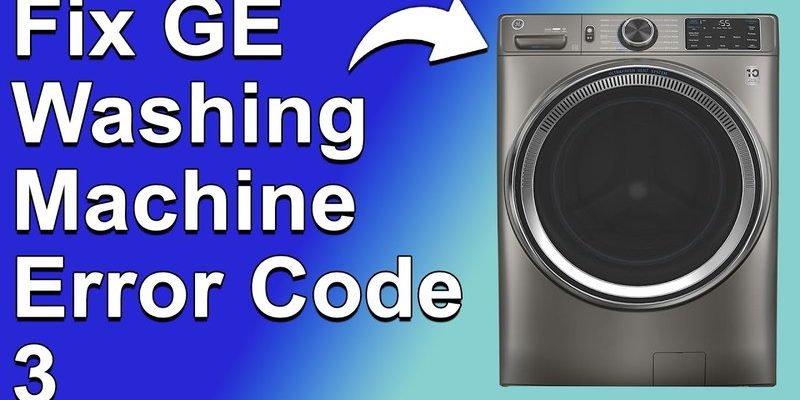
Imagine driving a car with a tiny rock stuck in the wheel. It might not be a big deal at first, but if you keep ignoring it, that small stone could lead to bigger issues. The same is true for washing machines. The LE error, short for “Locked Motor” error, signals a problem that, if left unchecked, can cause more significant headaches down the line. So, let’s dive into what causes this error and how to prevent it with some simple, everyday practices.
Understanding the LE Error Code
Before we rush to the solutions, understanding how this error code arises is crucial. Think of it as diagnosing the problem before fixing it. The LE error typically involves the washing machine’s motor, which is responsible for all the rigorous spinning and tumbling. Imagine if your arm was tied up in a knot; you wouldn’t be able to move it properly. Similarly, if there’s an obstruction or issue with the motor, the machine can’t operate as it should.
A common cause of the LE error is an overloaded machine. Picture trying to carry a week’s worth of groceries in one trip—it’s bound to end in disaster. Overloading your washer puts unnecessary strain on the motor. Another culprit could be a faulty wiring connection, much like a loose plug that doesn’t charge your phone. And sometimes, the motor itself might just be worn out, like an old pair of sneakers after years of use.
By understanding these causes, you can begin to see how preventing them is within your reach. Regular maintenance and being mindful of your washer’s limits can greatly reduce the chances of encountering this error code.
Regular Maintenance: A Lifesaver
You might be wondering, how often should you maintain your washing machine? Ideally, just as you service your car regularly, a washing machine benefits from routine care. Start by keeping the drum clean. Over time, detergent residue and dirt can build up, affecting performance. You wouldn’t let your car collect piles of dust inside, right? Similarly, take a moment each month to wipe down your washing machine.
Next, pay attention to the load you’re putting in. It’s tempting to shove everything into one wash, especially if you’re in a rush. But remember, overloading is a no-go. Stick to the recommended load capacity. Think of it this way: Just because a backpack can fit everything doesn’t mean it’s wise to fill it to bursting.
Another tip is to check the machine’s hoses for kinks or blockages. Much like a straw that’s pinched, a blocked hose restricts flow and can cause the motor to strain. Ensuring the hoses are in tip-top shape can prevent unnecessary stress on your washer’s motor, helping you keep that LE error at bay.
The Importance of Load Balance
Speaking of loads, balance is key—literally. Imagine trying to balance on a seesaw with a child on one end and an adult on the other. It’s no surprise that it wouldn’t work well. The same principle applies to your washing machine. An unbalanced load can cause the drum to spin unevenly, which can lead to that dreaded LE error.
To keep things balanced, distribute clothes evenly around the drum. If you’re washing a few large items, like towels or sheets, try to add smaller pieces around them to even out the weight. Think of it like assembling a puzzle, where every piece needs to fit just right for the best result. This ensures that the drum spins smoothly, reducing the risk of error codes.
Additionally, check for any small items, like socks or garments with strings, that might get tangled and disrupt the load balance. Taking a few extra seconds to arrange your laundry can save you from potential headaches and operational hiccups.
When to Call in the Professionals
Sometimes, despite our best efforts, the LE error might still crop up. It’s like diligently maintaining your car only to find it won’t start one morning. Don’t fret—this is when calling in the experts makes sense. A professional can diagnose deeper issues that might not be visible to the untrained eye. They have the tools and expertise, akin to a mechanic with a toolbox full of gadgets, to get your washer back on track.
Before you call, double-check your warranty. Some repairs might be covered, saving you some expense. When the technician arrives, don’t hesitate to ask for tips on maintenance or operation. They can offer valuable insights specific to your model.
In the meantime, keep implementing the preventive steps we’ve discussed. With these simple routine checks and mindfulness, you can significantly decrease the chances of encountering the LE error in the future, ensuring your washing machine continues to serve you effortlessly.
In summary, preventing the GE washing machine error code LE isn’t about mastering complex machinery—it’s about good habits and regular care. Treat your washer kindly, just as you would any other essential appliance, and you’ll find it operates smoothly for years to come.
